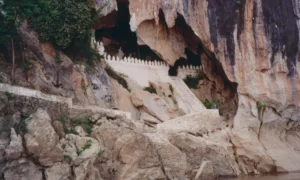The Pak Ou Caves are a historical marvel located in Laos, near the town of Luang Prabang. These caves are renowned for housing thousands of Buddha statues of varying sizes and styles. Carved into a limestone cliff at the confluence of the Mekong and Ou rivers, the caves have been a site of spiritual significance for centuries. They consist of two main caves, the lower Tham Ting and the upper Tham Theung, both serving as shrines to the river spirit and Lord Buddha. Pilgrims and tourists alike visit the Pak Ou Caves, drawn by their historical, cultural, and spiritual allure.
Lan Xang Kingdom
The Lan Xang Kingdom, also known as the “Land of a Million Elephants,” was a powerful and enduring kingdom in Southeast Asia, existing from 1354 to 1707 AD. Founded by King Fa Ngum, who was of Khmer and Lao descent, the kingdom was established with the help of a Khmer military force from the Angkor Empire. Fa Ngum brought with him a sacred Buddha image, the Phra Bang, which became a symbol of the legitimacy of the Lao monarchy and gave the kingdom its name, Lan Xang.
Under King Fa Ngum, Lan Xang expanded its territories significantly, incorporating parts of modern-day Thailand, Cambodia, and Vietnam. This expansion was often achieved through military conquests, as Fa Ngum sought to consolidate his power and spread Theravada Buddhism, which became the state religion. The adoption of Theravada Buddhism played a crucial role in shaping the culture and society of Lan Xang, influencing its art, literature, and governance.
The kingdom experienced its golden age under King Setthathirath in the 16th century, who is remembered for his military campaigns and for relocating the capital to Vientiane. Setthathirath also built the iconic That Luang stupa, a symbol of Lao sovereignty and Buddhism. His reign saw the strengthening of the kingdom’s defenses and infrastructure, as well as the flourishing of Lao culture and religious practices.
However, Lan Xang was not without its internal strife and external threats. The kingdom faced several invasions from its neighbors, particularly Burma and Siam (modern-day Thailand). The 16th and 17th centuries were marked by periods of warfare, which weakened the kingdom and led to its eventual division in 1707 AD into three separate kingdoms: Luang Prabang, Vientiane, and Champasak.
Social and daily life in Lan Xang was deeply influenced by Theravada Buddhism, agriculture, and the monsoon seasons. Rice cultivation was the backbone of the economy, with the majority of the population living in rural areas and leading agrarian lifestyles. Society was hierarchical, with a clear distinction between the nobility, clergy, and commoners. The royal court was a center of cultural and religious life, sponsoring literature, art, and public works.
The kingdom’s legal system, the “Dharmashastra,” was based on Hindu legal texts and Buddhist principles. It governed all aspects of life, from marriage and property rights to criminal offenses. This legal code reflects the syncretism of Hindu and Buddhist influences that characterized much of Lan Xang’s culture.
Throughout its history, Lan Xang was a melting pot of ethnicities, languages, and cultures, thanks to its strategic location at the heart of Southeast Asia. This diversity is reflected in the kingdom’s art and architecture, which show influences from the Khmer, Mon, and various Tai peoples. Despite the eventual fragmentation of the kingdom, the legacy of Lan Xang continues to shape the identity and culture of Laos today.
The rulers of Lan Xang, from King Fa Ngum to its last monarch, left behind a legacy of resilience, cultural richness, and religious devotion. Their efforts to defend their kingdom, spread Buddhism, and govern wisely are remembered and celebrated in Lao history and culture. The story of Lan Xang is a testament to the enduring spirit of the Lao people and their rich heritage.

